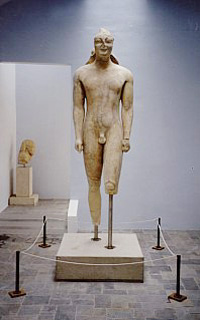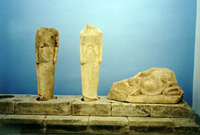| Ancient Samos |
|
 |
|
Traces of human presence in the island date from the fourth millennium BC. The name "Samos" is probably of Phoenician origin and according to Stravo means altitude near the coast. In written text, the word "Samos" appears for the first time in a Homeric Hymn to Apollo.
However, the island had other names, too: Anthemis, Doryssa, Dryoussa, Kyparissia, Imvrassia, Melamphyllos, Parthenia.
The Pelasghi are considered the island's older inhabitants. They were followed by the clans of Carians and Lelegians. The first king of Samos was the legendary king Ancaeus, one of the heroes of the argonautic expedition, who built the first wooden temple of the goddess Hera, the island's protector, near the mouth of the river Imvrasos, where, according to mythology, the goddess was born. |
|
| In the 11th century approximately, inhabitants of Ionia settled here with Tembrion and Procles who, being their leaders, spread their domination over the island. They divided Samos into two parts, Astipalaia and Chesia and they built the city of Samos in the place where the contemporary Pythagorio is located.
During antiquity, Samos enjoys its greatest prosperity in the 6th century, under the leadership of the tyrant Polycrates. The ancient historian Herodotus calls the island the first among all cities, both Greek and barbaric. Its navigation and trade flourish. Samian ships travel in the East and the West, bringing wealth and knowledge to the island. With its warships, the so-called samainas, it dominates over the Aegean Sea for a long time. The economic prosperity was parallel to the cultural development.
It was in that century that the greatest figures in the realms of culture and the Arts had distinguished themselves. Among the most well-known ones were the mathematician and philosopher Pythagoras, and the architects of Heraion, as well as pioneers of sculpture, Rhoecus and Theodorus. The island attracts artists such as Ibycus and Anacreon. It establishes colonies in Ephessus nearby and in Amorgos, in Samothrace and in Thrace, in distant Sicily, too. One is impressed by four ancient edifices, built during the same century; the Polycratean walls, the Tunnel of Eupalinus, the harbor mole and the temple of Hera, with her sanctuary, Heraion.
The four miles long Polycratean walls, protected the ancient city of Samos, encircling an area of 1,3 square yards. Even today the visitors are impressed by the very few parts of the walls that are still preserved.
The Tunnel of Eupalinus constitutes a major technical achievement in an age of minimal means and knowledge. It was constructed in the mid 6th century by the architect Eupalinus, from Megara, in order to supply water to the city. It is a construction of about one mile long, which is driven through the mountain and makes a great impression today for the excellent precision in the opening-up of the tunnel, considering that the simplest tools, such as hammer and chisel, had been used for clearing the ground from the rocks.
That water-supplying system had been working until the 7th century AC; in the following years its entrances were covered up and it was not discovered until 1882, from the monk Cyrillus Monina. The first cleaning operations at the tunnel began in that period. The Tunnel of Eupalinus was finally cleaned out and studied by German archaeologists in 1971-1973.
The third important construction of the Polycrates' reign was the harbor mole. The natural harbor in front of the city was divided, with the help of two breakwaters and other constructions, into two separate harbors: the outer harbor, which was used for the trade, and the inner harbor, which was used as a dockyard. The most significant work in the harbor was the "soil in the sea", a mole, that is, about 393 yards long, where the modern constructions of the Pythagorion port were founded.
When G. Konemenos became the prince of Samos (1851-1854), initiated the port's expansion, while later on, the prince Miltiades Aristarches (1859-1865) called the civil engineer Uman to make the plans for the construction of a new port in Tegani (the former name of Pythagorion). |
|
| The temple of Hera, the largest among those that Herodotus had seen, was located 3 miles westward of the city. A paved road, 13 feet wide, with statues and other offerings at both sides, linked the city with the temple of the goddess. This was 356 feet long, 180 feet wide and 82 feet high. It was built by the architect Theodorus, son of Rhoecus, and had 133 columns. Today only one column is preserved, thus, the surrounding area is called not only Heraion, but Colona (column), too. |
|
 |
|
| Other gods were also worshipped in ancient Samos and temples had been built to honor them, but the grandeur of Heraion outshone them all. Neptune was worshipped at the cape towards the Samos Strait, in contemporary Posidhonio, as well as Dionysus, Athena, Apollo and Venus. The greatest celebrations were dedicated to Hera, honouring the birth of the goddess and her marriage to Zeus. These festivities, the so-called Heraia, were celebrated with splendor and a grandiose procession started out from the city and, through the paved road, ended in the temple of Hera.
Another important celebration was the Tonaia, during which a miracle that the goddess had made was being represented. According to the myth, people from Argos stole the goddess�s sacred statue in order to bring it to their homeland. But no matter how hard they rowed away, their ship, instead of sailing in the open sea, returned to the shore and they managed to sail off only when did they disembark the statue on the shores of Samos.
At the Samos Strait, in Mykali, the sea between Samos and Asia Minor, the last great conflict between the Greeks and the Persians took place, in 479 BC. The Greeks won over the Persians in naval and in infantry battle, putting an end to their efforts to expand towards the West and to dominate the Mediterranean. After the Persian wars Samos participated with other city-states in the Athenian alliance, which never managed to abandon, even when the alliance became a powerful hegemony.
The efforts of the people of Samos to lead their own independent way was met with a powerful rejection on the part of the alliance, which, under the leadership of Pericles, in 439 BC, besieged and after three months conquered and destroyed the city of Samos. Since then, Samos was loyal to the Athenian alliance and followed, inevitably, its decline. |
|
|
 |
|
|
|